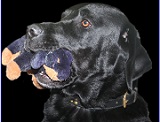Animal Instincts - can pets improve mental health?
 Animals can have a positive impact on mental health, as an example of one lady and her dog demonstrates:
Animals can have a positive impact on mental health, as an example of one lady and her dog demonstrates:
Animals have the capacity to influence positive emotional responses; they can lift our mood, improve our health and make us happy. These are sweeping generalisations, but as Rowan and Beck (2008) explain: “there is solid evidence that animal contact has significant health benefits and that it positively influences transient physiological states, morale and feelings of self-worth”.
Animal-assisted intervention, defined by Kruger and Serpell (2010) as “any intervention that intentionally includes or incorporates animals as a part of a therapeutic or ameliorative process or milieu”, is by its very nature ‘transient’. Selected animals generally interact with individuals during scheduled sessions of varying levels of formality.
Generally, human-animal interactions at home are also transient. Within this environment, Kurdek (2008; 2009) suggests canine companions can become ‘attachment figures’ operating in a similar way to a primary caregiver. His 2009 research, which included 975 dog-owning adults, found that in times of emotional distress most were more likely to turn to their dogs than mothers, fathers, siblings, best friends or children.
The impact of companion animals on human health and mental wellbeing is influenced by many circumstances, hence why academics explore whether benefits are ‘Fact, fiction, or hypothesis’ (Herzog, 2011).
With this in mind, personal experiences can provide fascinating insights into the human-animal bond, such as that of Tracey Doolan, 51, and her black Labrador Jack. Diagnosed with rheumatoid arthritis at 16, Tracey has had on-going health issues, enduring the first of many joint replacements at 24, neck surgery and hip surgery that almost left her wheelchair bound. “All this trauma has resulted in me having mental health issues of post-traumatic stress, panic attacks and depression.” she explains. “My saviour in all this is the work that I have been doing with Jack.”
Despite never wanting a dog, Tracey was convinced by her husband Lyndon to add one to their lives. The connection seemed instant: “I think that our bond started right from the very beginning,” she says. “There were two dogs to choose from. Immediately that I stepped into the barn Jack ran and sat in front of me. I honestly think that he chose me. At age nine months we were out on a walk and I fell in the road and was surprised that Jack didn't run off but stayed by my side until help arrived.”
Jack was intended to be a pet and received no training before joining the Doolans. “I saw dogs for the disabled on TV and thought that I would have a go and try and train him to help me,” says Tracey.
Tracey taught Jack how to open draws and cupboards, help remove clothes, socks, shoes and jackets, strip bedclothes, carry shopping, empty the washing machine, reach and fetch items from the back of low cupboards, and collect the phone and keys after falls. “I often catch Jack watching me when I am doing things and when he sees me struggling he will just come up without me asking and take what I am carrying and carry it for me. Although Jack doesn’t have an official jacket and certificate he does everything that a fully-trained dog would do and more.”
The time spent together and trust developed led to a close emotional bond. “While going through all the operations my focus was always on wanting to be back home with my dog. Having lost all confidence in going out and suffering panic attacks, Jack made me go out and face these challenges. I honestly don't think that I would have left the house if I had not had Jack by my side. I felt safe with him and knew he wouldn't let me down if I needed help.
“When I felt lonely and isolated Jack was always there. When I need help around the house Jack is there. My life has been made so much easier and much more fulfilling. I will be eternally grateful for having, as some people may say, ‘just a dog!’”
The circumstances from which animal contact can improve physical and mental wellbeing continues to attract academic attention. They will continue to explore how and why animals can have such positives impact in relation to animal interactions – some may say over-intellectualising the human-animal bond. But what is obvious from the experiences of Tracey and Jack is that animals do improve the lives of individuals, and more people should have that opportunity.
References
Herzog H (2011) The impact of pets on human health and psychological well-being: Fact, fiction, or hypothesis? Current Directions in Psychological Science 20 (4) 236-239.
Kruger KA & Serpell JA (2010) ‘Animal-assisted interventions in mental health: Definitions and theoretical foundations.’ In: Fine AH, editor, Handbook on animal-assisted therapy– theoretical foundations and guidelines for practice. Academic Press, San Diego, CA.
Kurdek LA (2008) Pet dogs as attachment figures. Journal of Social and Personal Relationships 25 (2) 247-266.
Kurdek LA (2009) Pet dogs as attachment figures for adult owners. Journal of Family Psychology 23 (4) 439-446.
Rowan AN & Beck AM (2008) ‘The Health Benefits of Human-Animal Interactions.’ In: Flynn CP ed. Social Creatures. A human and animal studies reader. Lantern Books: New York.
About the author
Dr Daniel Allen is a fellow of the Royal Geographical Society – he describes himself as an animal geographer. He has written two books, Otter (Reaktion Books, 2010) and The Nature Magpie (Icon Books, 2013). His current academic research focuses on pet therapy, please contact Daniel if you are interested in being involved at www.drdanielallen.co.uk.
This article first appeared in the September/October edition of Mental Health Today. For more information on the magazine, including details of how to subscribe go to: www.mentalhealthtoday.co.uk/mental-health-today/
Comments
Write a Comment
Comment Submitted